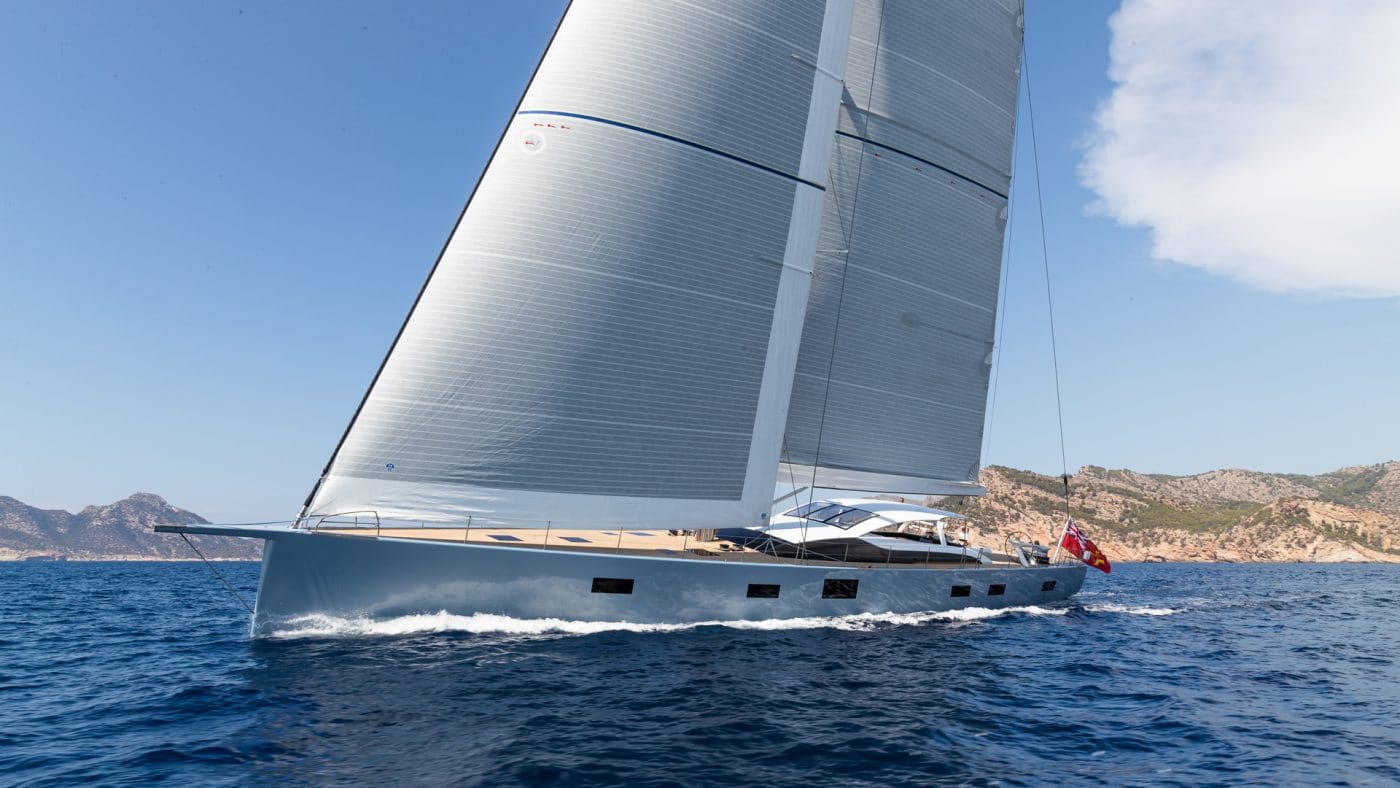
Baltic 112 Liara is a multi-role superyacht for global cruising and racing
6 September 2019
Commissioned by an experienced yachtsman, Liara is a fast, easy to handle, long distance family cruising yacht with potential to perform well on the racecourse.
Following her launch in Finland, the 112ft/34.14m sloop has been undergoing sailing trials and crew training in the Mediterranean with plans to cross the Atlantic this winter to take part in the RORC Caribbean 600 and the St Barths Bucket 2020. From there she will transit the Panama Canal with the aim of being in New Zealand for the America’s Cup in 2021.
Prior to this Baltic Yachts has the pleasure of exhibiting Baltic 112 Liara during the prestigious Monaco Yacht Show, September 25th – 28th. She will be directly in front of the Monaco Yacht Club, Quai L’Hirondelle berth no H30, where the Baltic Yachts’ team will be looking forward to welcoming you.
Cruising yacht with a performance edge
The owner’s original intention was to build an out-and-out performance family cruising yacht, but as naval architect Malcolm McKeon explained, things soon changed.
The goal posts moved when it was decided she was also going to go racing and that we needed to focus further on weight saving, said Malcolm.
Baltic Yachts’ in-house project manager Tommy Johansson said that strict adherence to weight schedules and the dedication of the build team on the shop floor found ways to further reduce weight. Liara’s final light ship displacement was measured at 88 tons.
Using computerised fluid dynamics (CFD) studies, MMYD were also able to confirm a considerable increase in performance provided by the yacht’s Retractable Propulsion System (RPS), especially in light to medium airs.
It was clear that the yacht would accelerate and power up much more quickly than expected with her propeller retracted, said Malcolm.
A major engineering challenge for Baltic Yachts and the project team was posed by the juxtaposition of the hull aperture for the RPS and the telescopic keel.
It took us eight months to plan and engineer this, but we remained on schedule, said Tommy Johansson.
The original machinery configuration was for a single engine and twin generators, but it was decided to fit a shaft generator so that one of the conventional generators could be discarded, saving space and weight. The main engine is offset and drives the RPS via a 90 degree bevel gear box. With a large lithium ion battery bank Liara can run in ‘silent’ mode for up to eight hours with all ‘hotel’ services running, including air conditioning.
MMYD worked carefully on the shape and positioning of hull appendages to reduce wetted surface and drag. Work was also done to streamline the ‘steps’ created by the telescopic keel fin to make the section more hydro-dynamically efficient. Through-hull fittings were reduced to a minimum to further reduce drag and for the same reason it was decided to opt for a single rudder, which also reduced weight.
The other great advantage of a telescopic keel is that, unlike a conventional lifting keel, it doesn’t encroach into the accommodation so when we were working with Adam Lay on the interior we had an immediate advantage in the deck saloon, said Malcolm McKeon.
With her powerful sailplan, RPS, which also rotates to act as a stern thruster, telescopic keel, high pressure hydraulics system for faster line speeds and high voltage electrical specification, Liara displays the latest thinking for a multi-role superyacht.
An added benefit of both the hydraulic and electrical systems is that they require considerably smaller diameter pipework and lighter electrical cabling which saves weight and space. The weight saving programme is supported by titanium being used in everything from stanchions and deck fittings to the hydraulic oil reservoir.
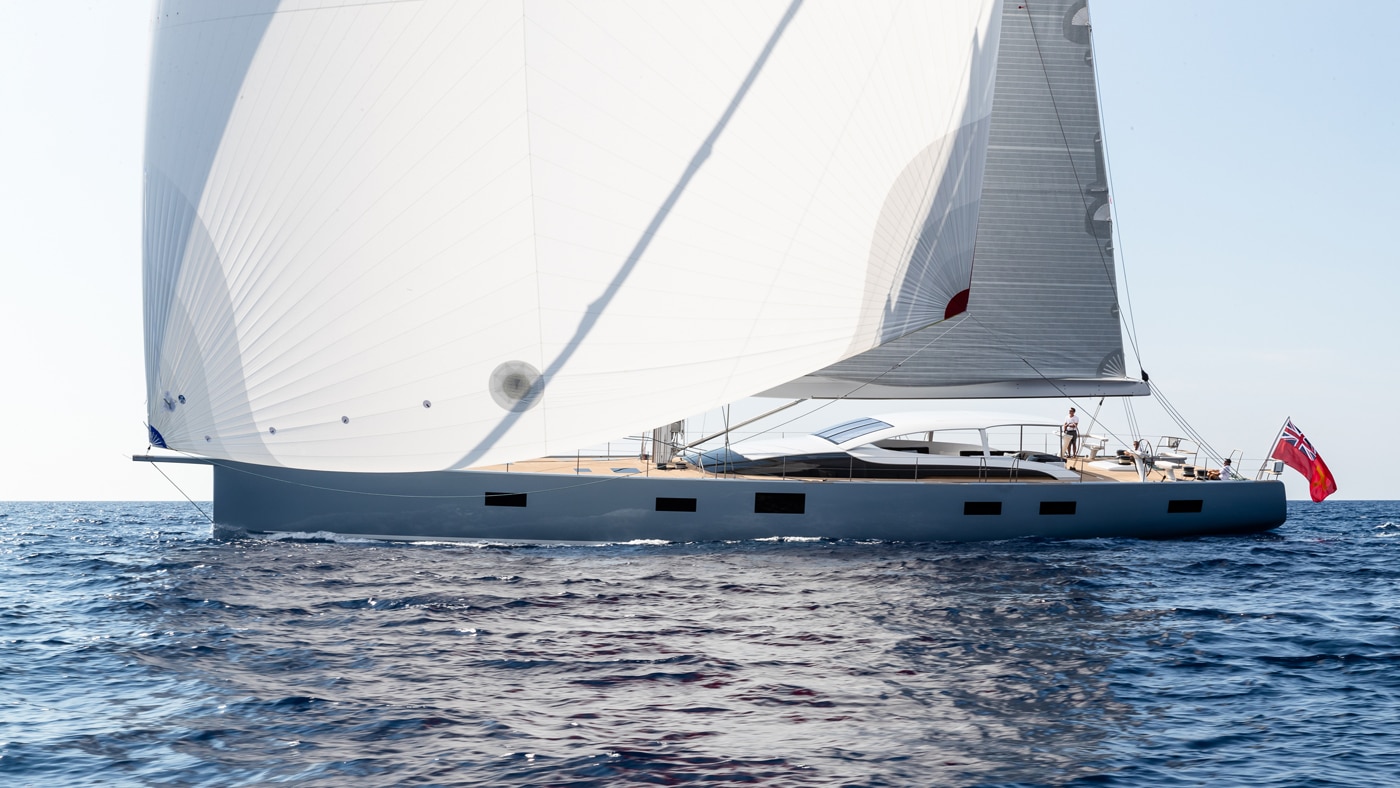
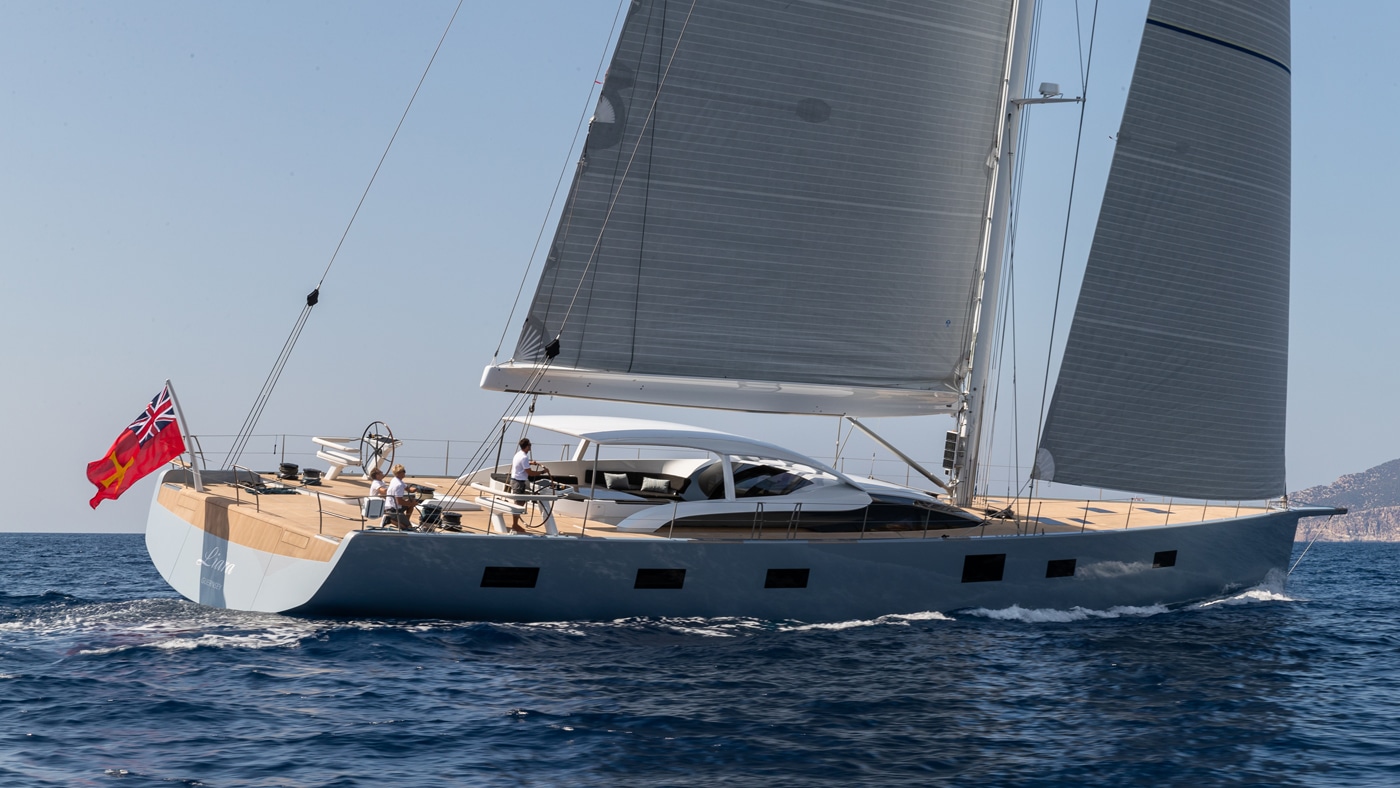
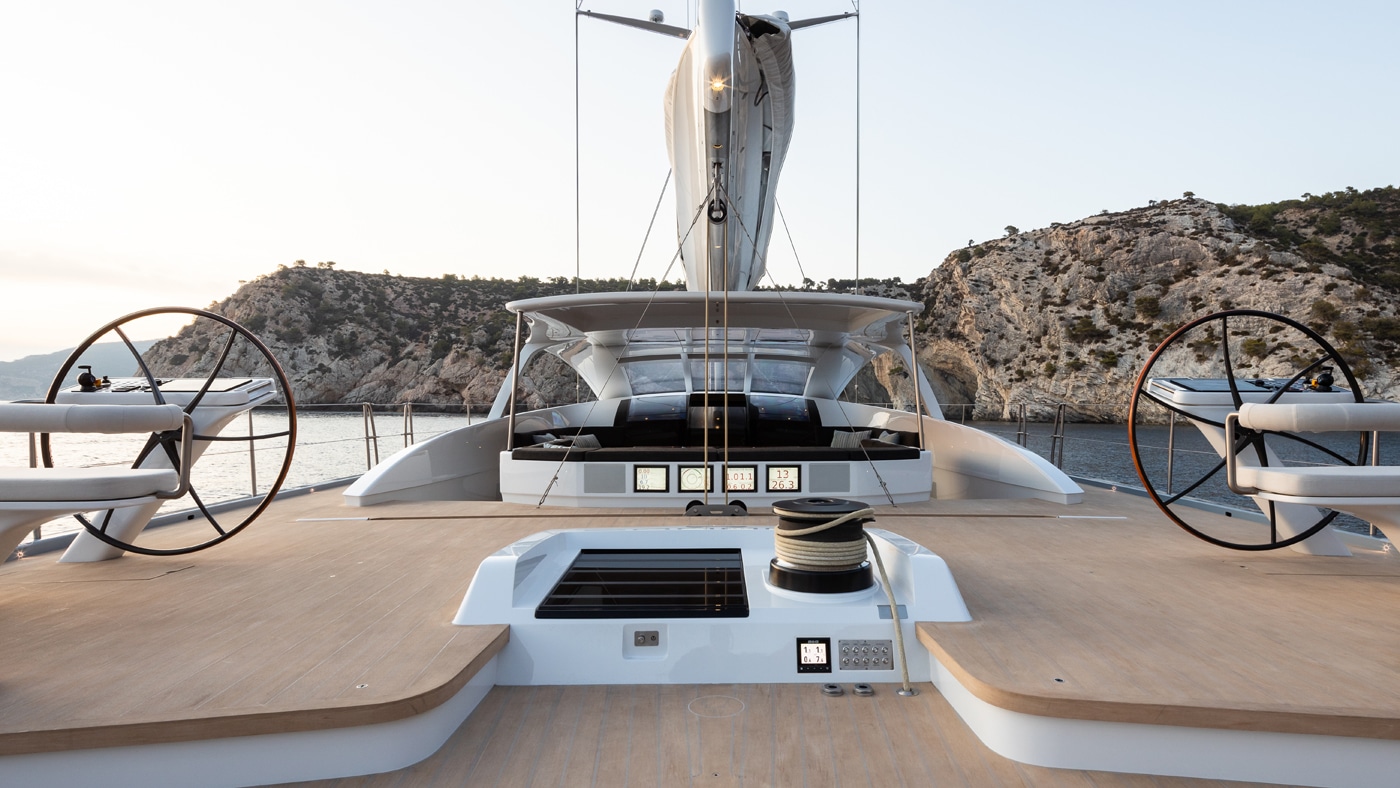
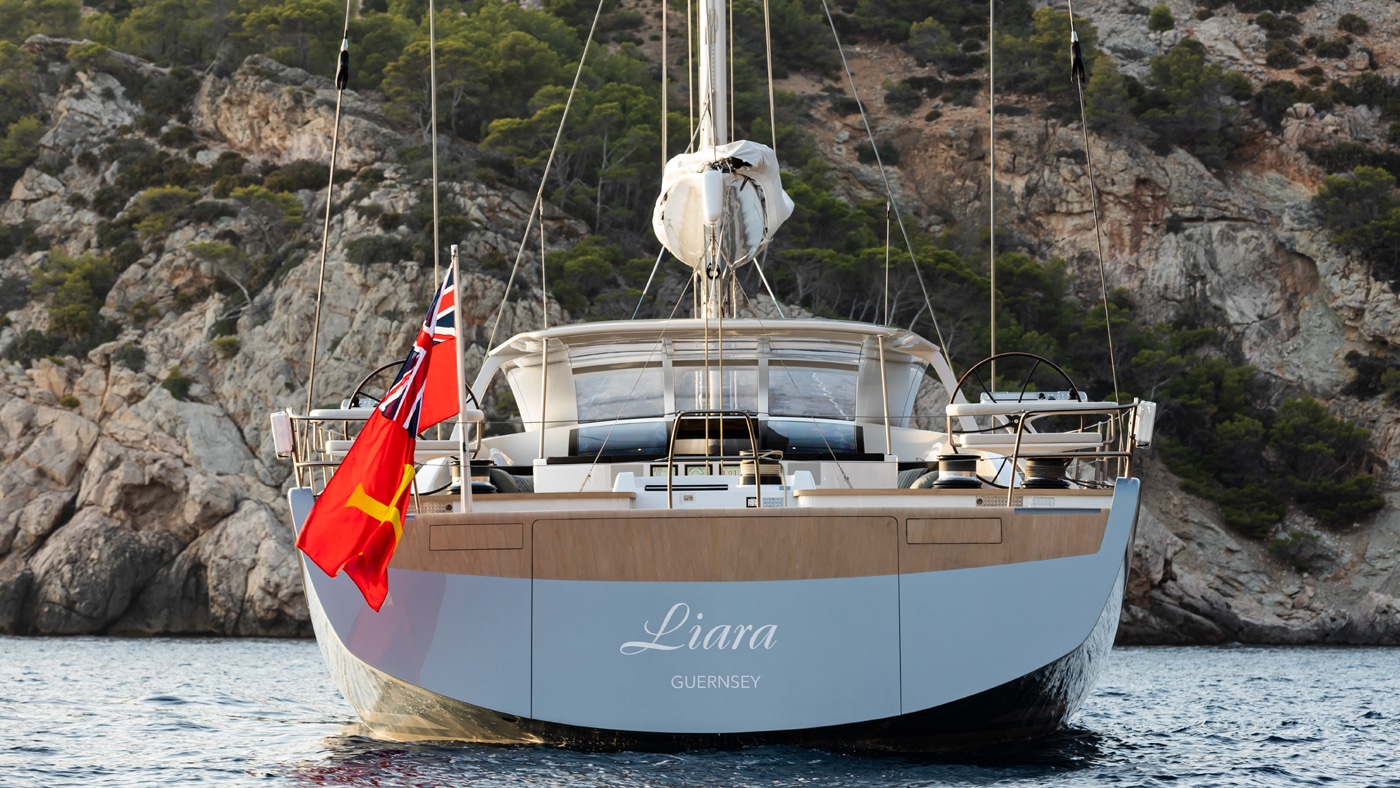
Advanced composite two-part hull moulding
Liara’s advanced carbon composite hull shell was built in two parts for easy access and a faster, more accurate build. Further weight saving was achieved by the use of carbon cable trays and hose holders and Nomex-cored furniture construction throughout.
MMYD has drawn an easily-driven hull with powerful stern sections for optimal reaching performance. The project team worked closely with Southern Spars and the North Sails technical group, using their virtual wind tunnel programme, to develop Liara’s sail wardrobe. It includes a wide choice of code and asymmetric sails set on fixed or soft stays with halyard locks, tacked to the deck or forward on the integral bowsprit. With performance again in mind, the mainsail area was boosted with a square-top configuration.
Ease of use paramount
As an experienced yachtsman with a keen interest in engineering, the owner used the knowledge gained from his previous yachts to make Liara easy to handle by the core crew so that she could be quickly prepared for sailing.
By focusing on systems usability, these and other details make handling Liara’s running rigging and sail inventory much easier and faster so we can be sailing from anchor up in the shortest period of time, explained co-skipper John Walker.
Both Liara’s skippers, John Walker and Tom Haycock, who work on a rotational basis, have considerable experience in the J Class fleet and a lot of detail deck design and ergonomics from that sphere of yachting has been used to help make Liara as easy as possible to sail.
Four hydraulic rams positioned under the foredeck provide touch button control of three-dimensional headsail sheeting bridles and rig ‘deflectors’ which enable the shape of the Southern Spars mast to be controlled.
A ‘winch farm’ by way of the mast partners, together with mast exit sheaves and rope tail compartments below deck level, can be hidden by sliding hatches once the yacht has been prepared for sea.
Further forward, asymmetric and Code sails each have dedicated bins so that they can be accessed and stowed quickly and easily. Right aft, Liara’s primary winches have been positioned abaft the steering positions enabling easy ‘cross-winching’ – taking the headsail sheet to weather for trimming and other manoeuvres – and keeping the guest area completely free of running rigging.
An interesting on-deck feature is a manually operated carbon fibre derrick that can be mounted in two positions enabling the 5.5m Ribeye tender to be stowed athwartships on the aft deck for passage-making or on the foredeck when Liara is at anchor.
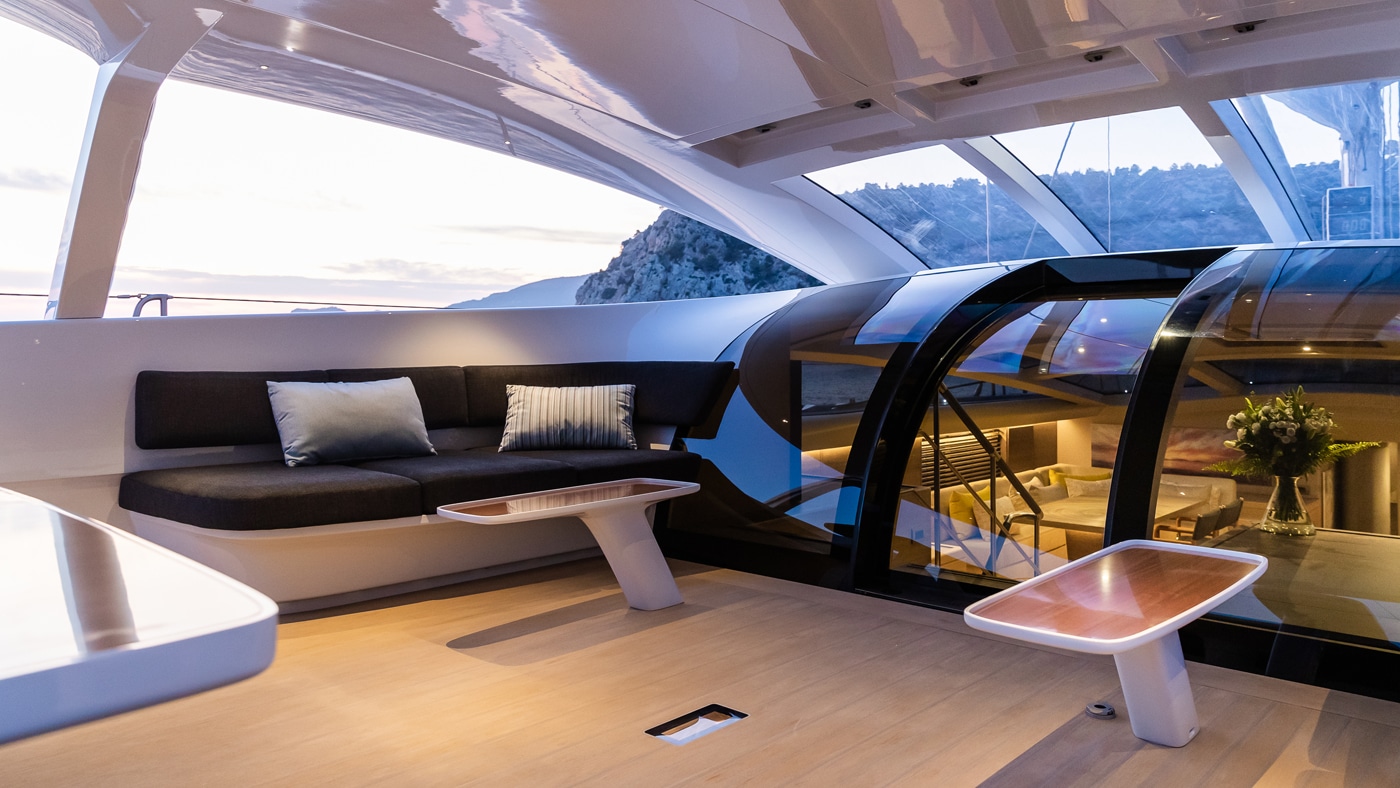
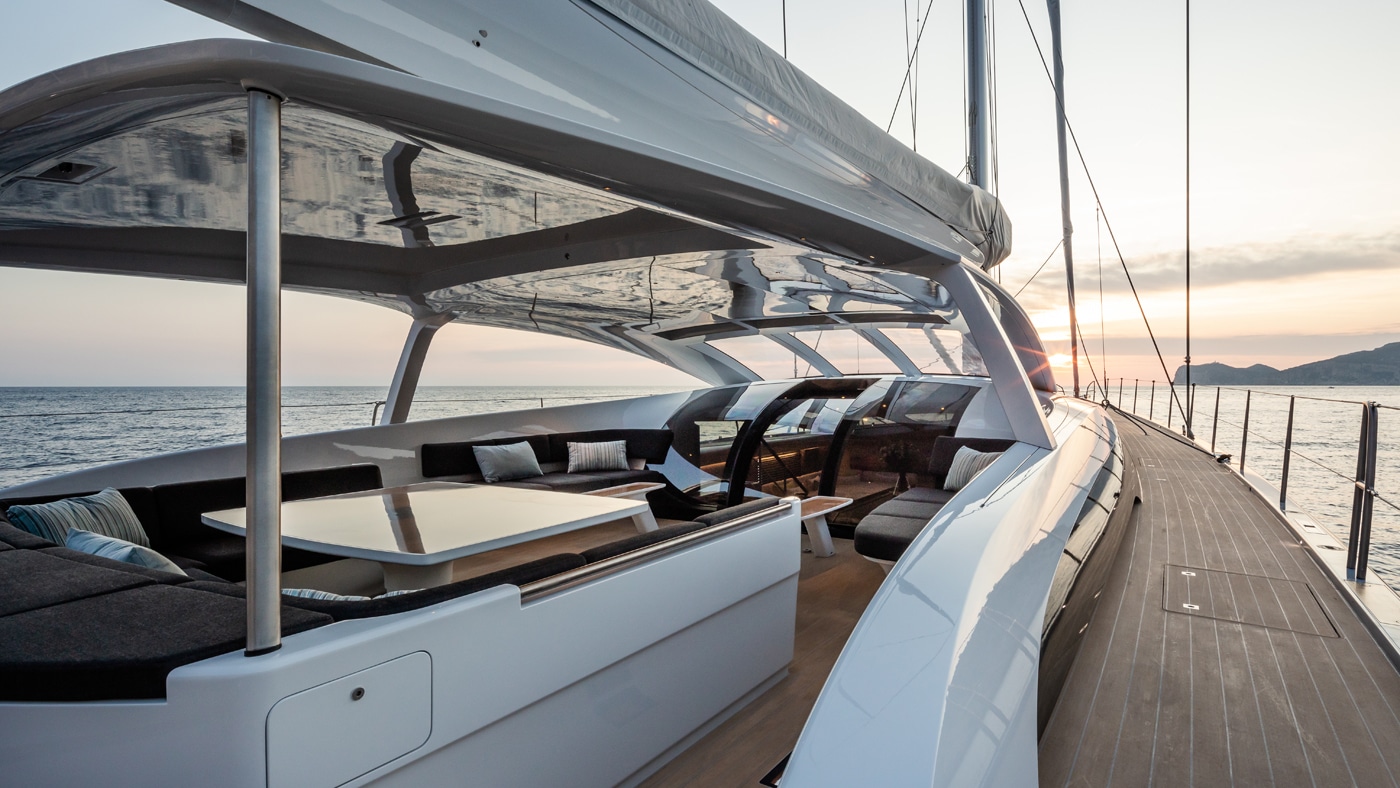
Comfortable family cruising platform
The overriding requirement was a for a safe, comfortable family cruising platform and the yacht’s large, deep cockpit protected by a distinctive, hard-top bimini, removable for racing, is central to the design. This leads into the dramatic full width deck saloon providing the first glimpse of the superb Adam Lay Studio-styled accommodation (see statement below).
The use of wide, curved glass companionway doors not only maintains a ‘connection’ with the cockpit for those sitting in the deck saloon but provides the helmsman with a sightline right forward.
John Walker, who worked with Liara’s owner on his previous yacht and was heavily involved in the pre-build planning of this yacht, summed up the project like this:
I feel its success comes down to working with an extremely experienced owner who has selected a fantastic, like-minded team. His choice of Baltic Yachts, Malcolm McKeon Yacht Design, Sebastian Allebrodt of A2B Maritime project management and the Adam Lay Studio, amongst others, has meant the whole build process has been successful and pleasurable from start to finish.
An exceptional study in interior design
The Adam Lay Studio was commissioned to design Liara’s interior. We asked Adam to describe the project in his own words.
“The design brief for Liara was to create a practical, functional sailing yacht interior with smart stowage solutions and an open feel that reflects the natural environment of the owner’s home islands, the Channel Islands located between England and France.
“An immensely practical man with an intense interest in engineering, the owner, together with his wife wanted the interior design to capture the atmosphere of the islands. Adam Lay Studio was asked to design an interior with a natural aesthetic augmented by bright colours in the soft furnishings inspired by the incredible colours of the island environment.
“From the beginning of the project, close attention was paid by the design and build team to devise smart under-sole stowage solutions with a track and box system allowing access to otherwise under-utilised spaces. Required stowage areas were carefully measured from the owner’s previous vessel to be matched or enhanced on the new-build, even accessing spaces inside the dining table base and coffee tables. It is safe to say that every available space has been used!
“The owner understands the importance of good crew accommodation for the successful running of the vessel so a generously-sized mess and crew cabins were an important part of the design brief.
“Malcolm McKeon Yacht Design gave us an absolute gift in terms of the structure and space planning for the saloon which, in terms of its feeling of openness, is incomparable with any vessel of Liara’s size. I would argue this area of the yacht boasts a game-changing design – albeit a challenge for the shipyard to accommodate the necessary ducting and pipework from the mid-ship section to the aft cockpit area.
“The result is a very open feel to the saloon and a remarkable connection to the cockpit making both spaces work together. Headroom was kept to a maximum by recessing the deckhead panels between the structural beams, thus creating a feature of the structure and allowing MMYD to keep the deckhouse as low as possible to benefit the profile.
“Liara’s interior is intentionally ‘weathered’ to look and feel natural, comfortable and relaxing. This neutral backdrop is intended to future-proof the vessel in the event of resale allowing any potential subsequent owners to decorate the interior to their own taste. Colour is introduced in the soft furnishings which are complemented by artwork created by local Guernsey based artist Valerie Travers.
“The dining table and coffee table surface finishes are designed to mimic ripples in calm water. The hanging locker doors are also designed to reflect the appearance of water or tree bark – the intention always being to use stylised elements and not a literal facsimile to create an atmosphere. The textures on some of the fabrics chosen continue this feel and the lighting is carefully positioned to pick up and highlight these elements.
“The accommodation comprises (from forward to aft) an owner’s suite in the bow, a VIP suite alongside a lower saloon area (snug), a spacious saloon amidships and two twin guest cabins aft. The crew accommodation comprises galley, crew mess and laundry, office/temporary cabin, navigation station and two en-suite twin crew cabins with en-suite heads.”
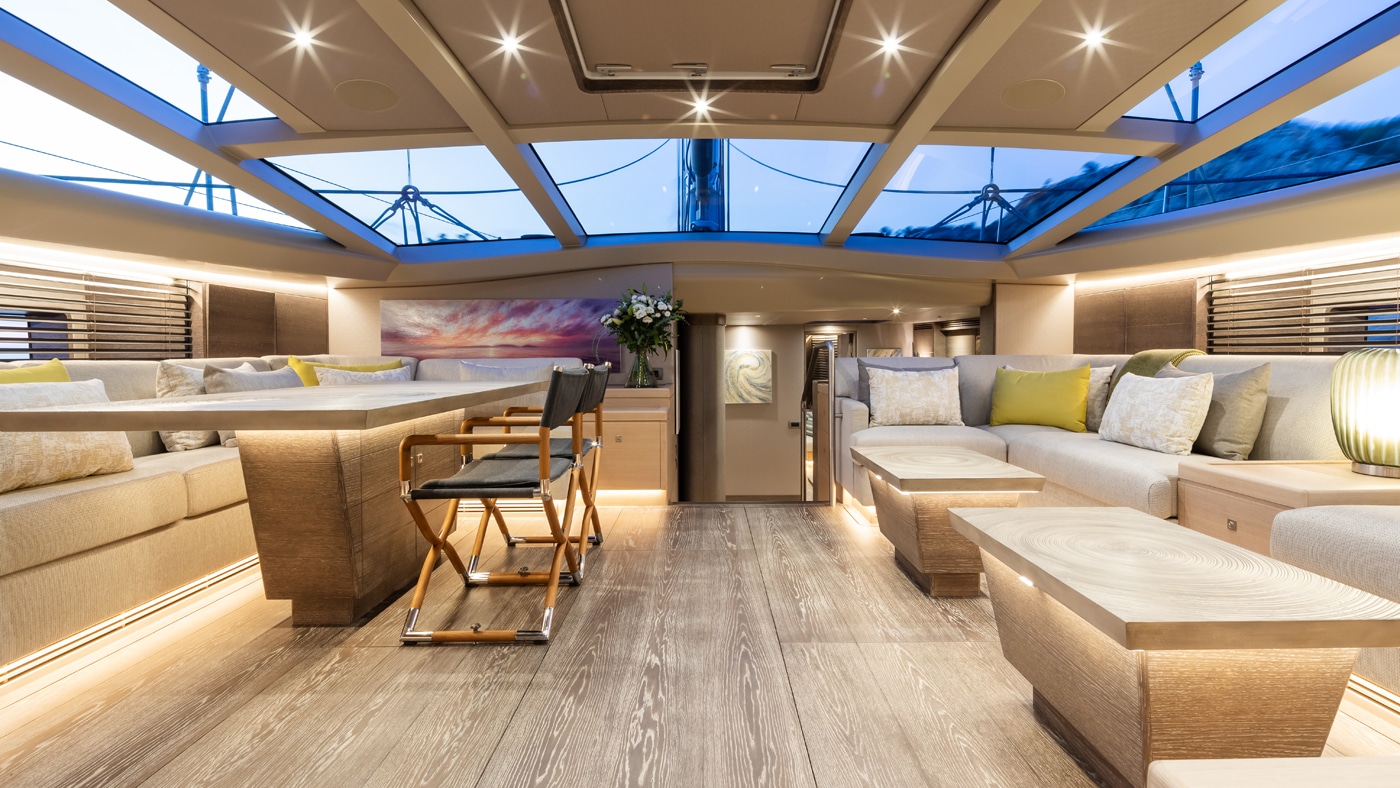
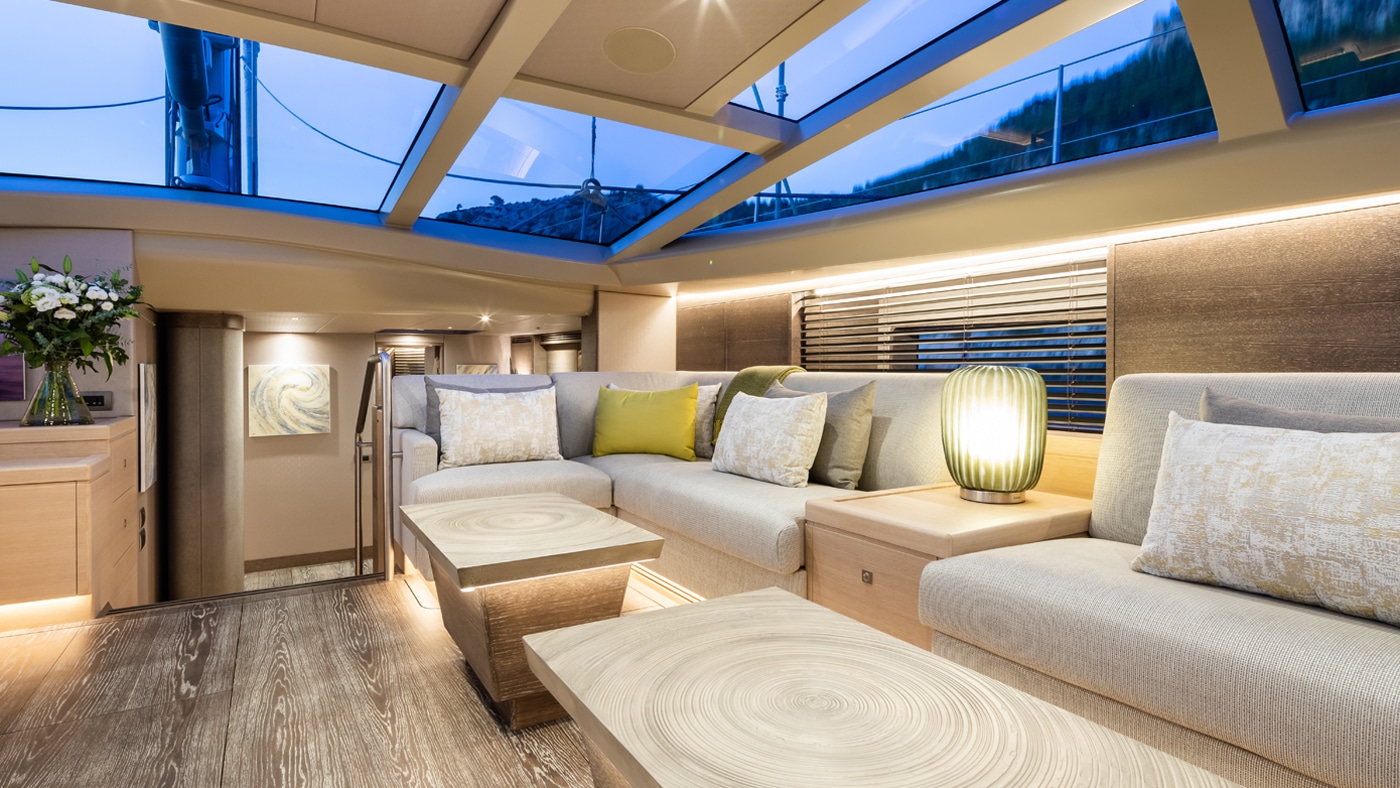
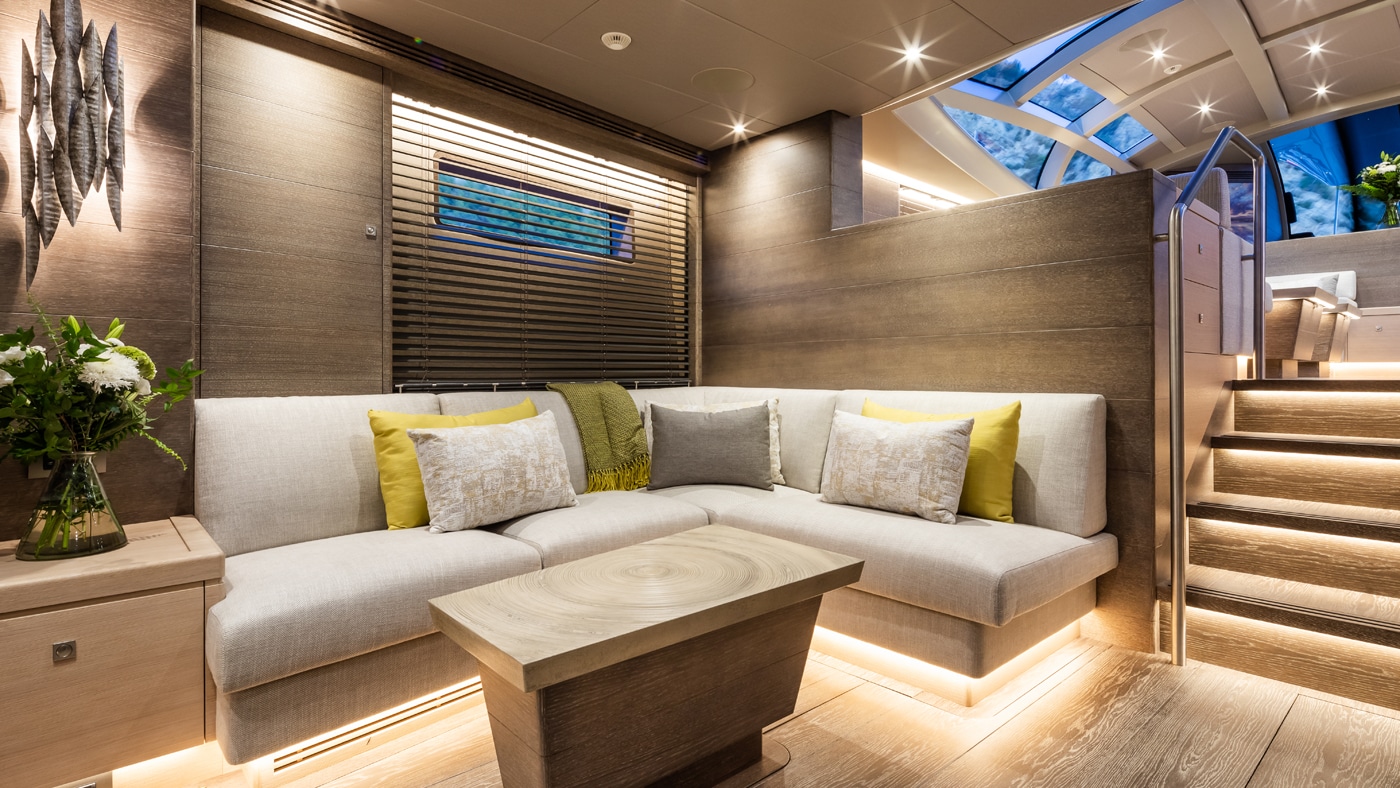
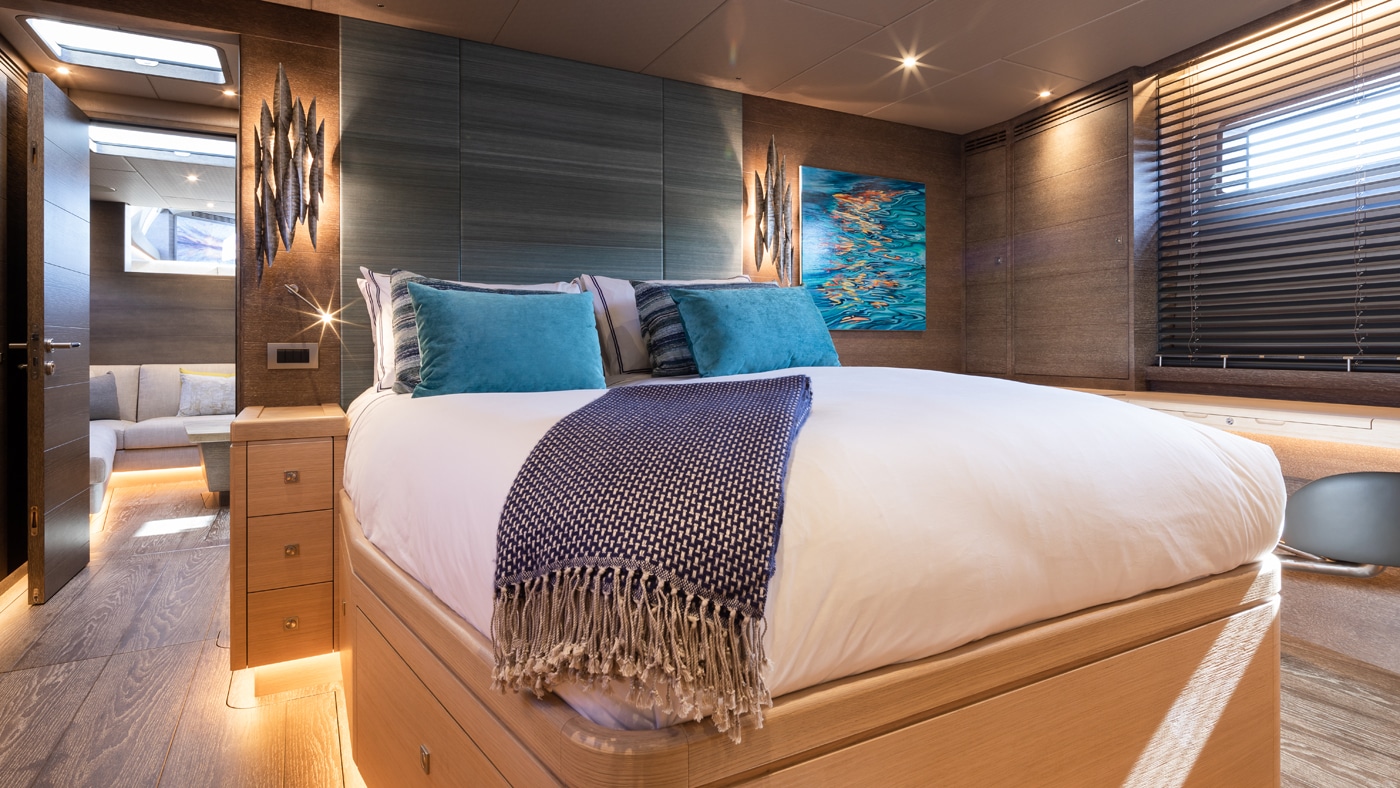
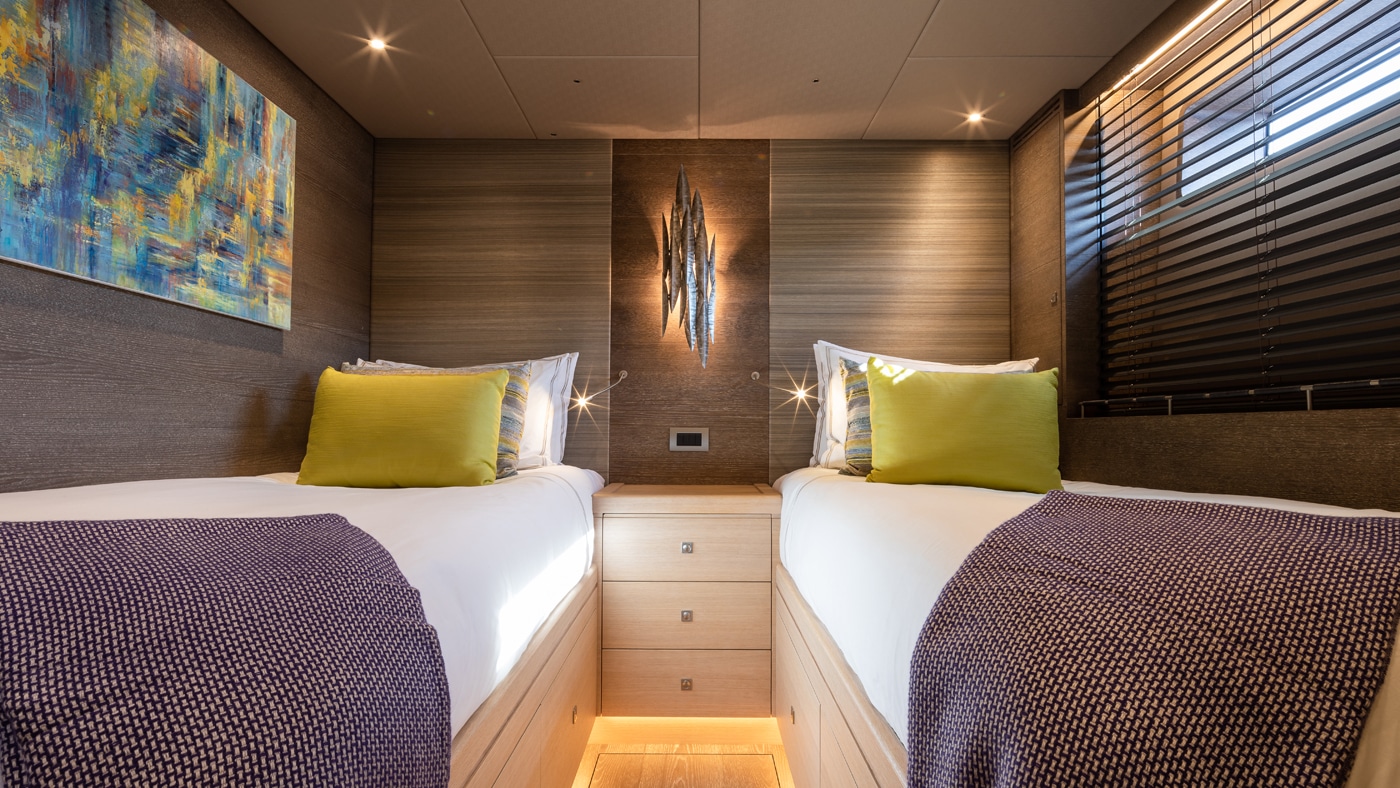
DIMENSIONS
LOA 34.14m
LWL 32.00m
Beam 7.90m
Draft, keel up 3.95m
Draft, keel down 6.15m
Light Displacement 88 tons
Ballast 34 tons
DESIGN
Naval architect and Exterior Styling: Malcolm McKeon Yacht Design
Interior design: Adam Lay Studio
Owner’s representative: A2B Maritime
